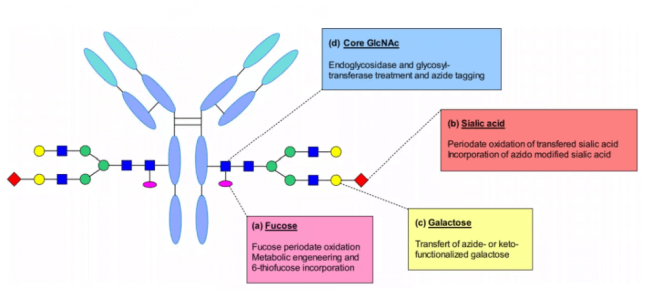Glycan coupling
Because IgG is a glycoprotein, it contains an N-glycan at n297 of CH2 domain of each heavy chain of Fc fragment. This glycosylation can be used as the attachment point of connecting payload. The long-distance localization between polysaccharide and Fab region reduces the risk of damaging the antigen binding ability of antibody after coupling. In addition, compared with the peptide chain of antibody, their chemical composition is different, allowing site-specific modification to make them suitable coupling sites.
Glycan biocoupling can be distinguished according to the technology used to target carbohydrates: including glycan metabolic engineering, glycan oxidation after glycotransferase treatment, endoglycosidase and transferase treated ketone or azide labeling.

Neri et.al reported site-specific modification of fucose at the N-glycosylation site of IgG antibody. This sugar contains a cis diol moiety suitable for selective oxidation. They use sodium metaiodate to oxidize fucose residues to form an aldehyde group that can react with hydrazine containing linkers, so that the antibody is connected to the drug through hydrazone bonds.
Senter and colleagues added sulfur based analogues to the cell culture medium to bring 6-thiofucose into antibody modification through metabolism. They believe that substitution is accomplished by hijacking the fucosylation pathway, which introduces chemical sites to achieve site-specific binding. Compared with classical cysteine conjugates, this method significantly reduces the level of heterogeneity and produces conjugates with more predictable pharmacokinetic and pharmacodynamic properties.
Sialic acid is rarely contained in recombinant IgG. However, it has been proved that glycine can be enzymatically modified by galactosyl and sialyltransferase. Galactose was added by enzymatic reaction to obtain G2 glycan, and then terminal sialic acid was added. This modification generates aldehyde groups through periodate oxidation, which can couple linker payloads with hydroxylamine groups. The conjugate has high targeting selectivity and good antitumor activity in vivo. Periodate can also oxidize sensitive amino acids such as methionine and affect the binding with FcRn.






 View the Knowledge base of Antibody-drug Conjugate (ADC)
View the Knowledge base of Antibody-drug Conjugate (ADC)